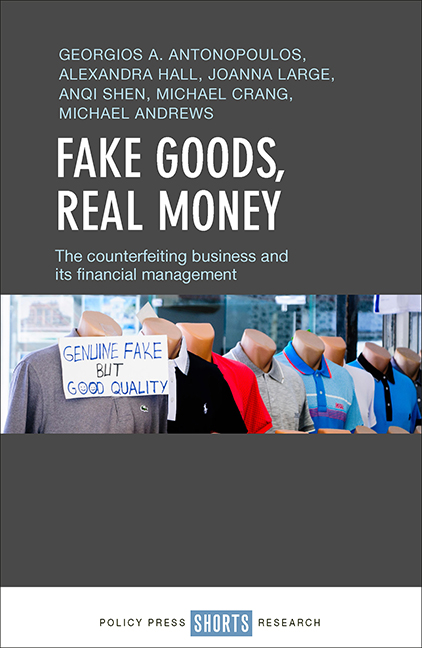Book contents
one - Introduction
Published online by Cambridge University Press: 12 April 2022
Summary
“There are two categories for the things that are counterfeited. There is everything and there is anything.” (Interview with Police Intellectual Property Crime Unit Officer)
The trade in counterfeit and pirated goods is stated to be one of the fastest-growing businesses in the world (Lin, 2011). The World Trade Organization estimates that 7% of all global commerce is counterfeit (UNODC, 2015). The World Economic Forum goes further, suggesting that in 2015, counterfeiting and piracy equated to 10% of the global trade in merchandise, costing the global economy US$1.77 trillion (World Economic Forum, 2015: 3; see also UNODC, 2015). We must acknowledge that, of course, no one knows the scale of counterfeit trade, and there are problems with the estimates, for example, faked goods being valued as directly losing the value of the originals, which assumes that all purchasers of counterfeits would have bought a full-price original, and, more generally, a reliance on heroic estimates from reputable bodies and a tendency for large estimates to trump smaller ones (Andreas, 2010; see also Intellectual Property Office, 2017). Despite the caveats, it is reasonably safe to accept the international law enforcement agencies’ view that the trade in counterfeit and pirated goods is now one of the world's most profitable illicit markets.
Product counterfeiting takes place in a number of dimensions, which include safety-critical and non-safety-critical goods, deceptive and non-deceptive counterfeits, and high- and low-quality fakes. The level of imitation and intellectual property (IP) infringement can also vary from the unauthorised use of a brand name, to the use of intentionally incorrect names and logos that resemble a brand, to the unauthorised sale of a legitimately produced designer product (see Lin, 2011: 5). Indeed, ‘counterfeiting’ has become a catch-all phrase used to encompass the illicit production and distribution of goods and packaging that infringe intellectual property rights (IPRs). The category includes patents, trademarks and copyrights, as well as poor-quality and fake goods that use ‘fake brands’ created by the counterfeiters themselves and therefore do not involve IP infringement (Shen, 2017). In some instances, it can be useful to situate the production and distribution of fake goods in their respective legal categories, which include counterfeiting (goods violating a trademark, design rights or patent), piracy (tangible goods violating a copyright), imitations, grey-area products and custom-made copies (Prendergast et al, 2002, cited in Gessler, 2009: 36).
- Type
- Chapter
- Information
- Fake Goods, Real MoneyThe Counterfeiting Business and its Financial Management, pp. 1 - 8Publisher: Bristol University PressPrint publication year: 2018



